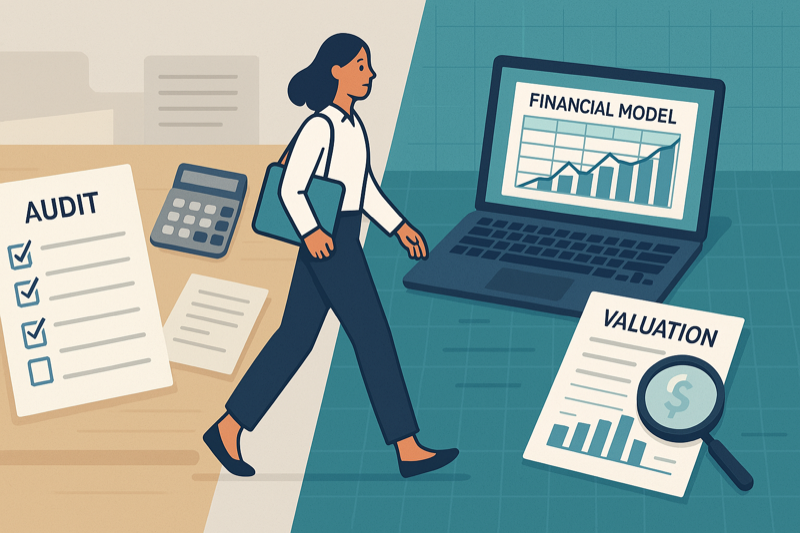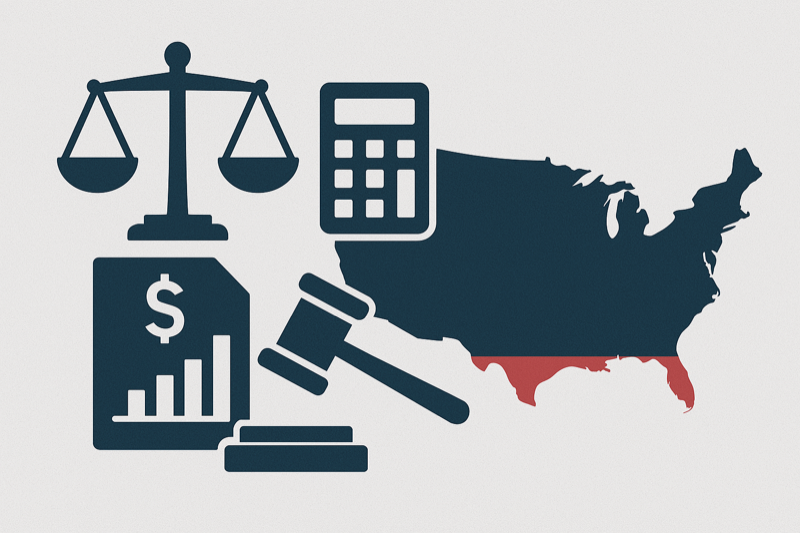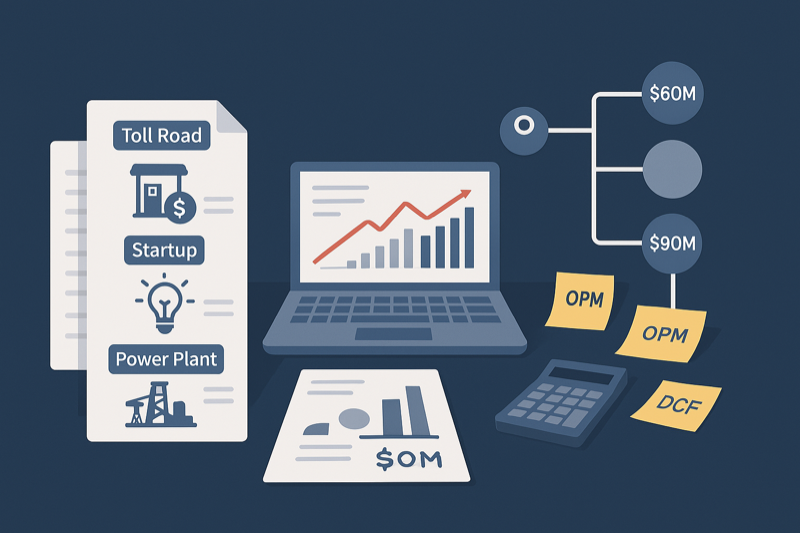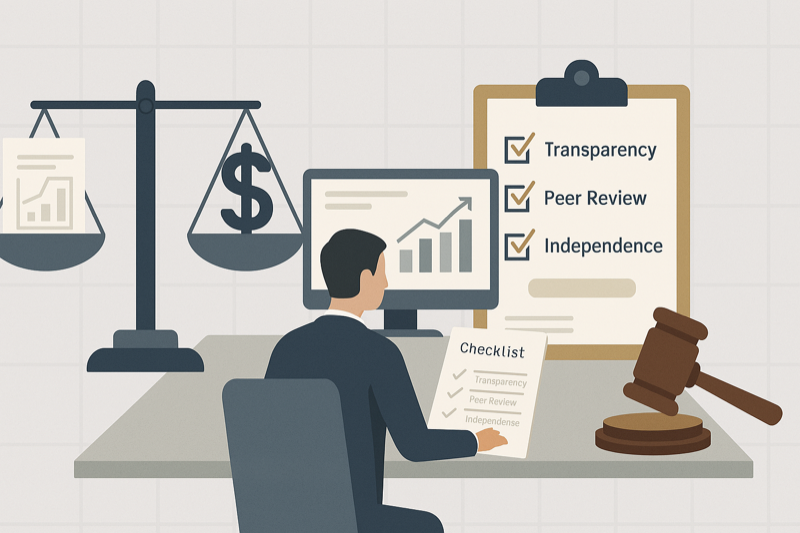Blog Insights


Every career begins with a choice. For me, that choice was audit. It offered structure, discipline, and the chance to build a strong foundation in accounting and financial reporting. I valued those early experiences—the rigor of audit checklists, the exposure to financial statements, and the systematic understanding of controls. But over time, I realized something was missing.
Audit, by its nature, involves a degree of repetition. Each cycle brings familiar tasks—testing controls, reconciling accounts, verifying compliance. While this repetition is essential for consistency and reliability, it gradually became clear that it did not satisfy my intellectual curiosity. I was learning, but not in the way that challenged or excited me. My interests were beginning to lean toward something more analytical, more judgment-driven, and more strategic.
That realization wasn't immediate. It came subtly, project by project, as I found myself more interested in the broader business questions behind the numbers. I wanted to understand value, not just verify that it had been recorded correctly. I started paying closer attention to discussions around impairment testing, fair value adjustments, and business combinations. These weren't just compliance tasks—they were windows into how companies were actually assessed and understood by stakeholders.
This was the turning point. I started exploring valuation—first through internal discussions and shadowing colleagues, then by reading valuation models and reports in my own time. I began to appreciate the judgment and nuance involved. Unlike audit, valuation isn't about confirming the past—it's about estimating the future. That shift in mindset was exactly what I had been looking for.
Making the pivot wasn't easy. It meant upskilling rapidly, changing my network, and being willing to start from a place of partial knowledge. I invested time in learning valuation methodologies—discounted cash flow, comparable company analysis, and precedent transactions. I built models from scratch, dissected fairness opinions, and sought feedback from more experienced peers. The learning curve was steep, but it was energizing.
What surprised me most was how much of my audit background turned out to be useful. Understanding financial statements, identifying accounting adjustments, and critically evaluating documentation—all of that carried over into valuation work. But now, instead of looking backward to verify, I was looking forward to interpret and project.
Valuation requires you to form an opinion, to defend assumptions, and to synthesize qualitative and quantitative inputs. It is both art and science. Each engagement is different. The work is more fluid, more judgment-heavy, and more dependent on context. That's what I had been searching for without knowing it.
Today, I work in valuation full-time. I evaluate businesses, assets, and strategies across industries and geographies. I still use my audit lens—it keeps my models grounded and my questions sharp—but now I'm asking different questions. What is this business worth? What are the key risks? How does this compare to market expectations? What does the future cash flow profile really tell us?
The transition from audit to valuation was not just a change in job description. It was a deeper alignment with what I enjoy doing and how I think. For those considering a similar move, my advice is simple: don't wait for permission. Explore, ask questions, and if something doesn't feel right, trust that instinct. The right path might not be a straight one, but it will be yours to build.

Valuation Techniques for Infrastructure Projects

Valuing infrastructure projects involves deep structural understanding due to their long durations, regulatory influence, and capital-intensive nature. These assets, which include toll roads, airports, utilities, and renewable energy installations, generate stable but highly contextual cash flows. Traditional valuation methods need to be adapted to match the scale, timeline, and complexity of these projects.
Discounted Cash Flow
Discounted Cash Flow (DCF) is the most common and reliable approach for infrastructure. The extended useful life of these assets allows for long-term forecasting, often over 20 to 30 years. The model should be built with specific focus on how the project earns revenue, its cost structure, capital expenditures, and risk factors that could alter the trajectory of cash flows.
Revenue is modeled based on demand forecasts, pricing mechanisms (such as toll rates or feed-in tariffs), and contractual protections like minimum revenue guarantees. Costs should be split into fixed and variable components, and capital expenditures must be phased in according to construction schedules or lifecycle replacements.
Terminal value is typically estimated using a perpetual growth model or by projecting asset value at the end of the concession period. Weighted Average Cost of Capital (WACC) needs to reflect both systematic and project-specific risks, which may include political influence, construction delays, regulatory changes, and operational uncertainty.
Regulated Asset Base Approach
For assets governed by regulatory frameworks, especially in energy and utilities, the Regulated Asset Base (RAB) approach is highly relevant. The RAB is derived from the historical cost of investment, net of depreciation, and is periodically updated by regulators. Investors are allowed a return on the RAB, often benchmarked to inflation-indexed rates. This approach reduces uncertainty and supports valuation by creating a predictable framework for cash flow generation. However, it requires deep familiarity with the regulatory process, which varies by jurisdiction.
Real Options Valuation
Projects that involve significant flexibility or uncertainty benefit from real options analysis. This method captures the value of managerial choices, such as expanding capacity, delaying investment, or changing operating strategies in response to external events. Monte Carlo simulations or binomial trees are often used to quantify this value. Real options are particularly useful for infrastructure projects with political risk, commodity exposure, or policy-driven incentives.
Comparable Transactions
Comparable market data is often used as a cross-check, although finding similar assets with comparable concession terms, revenue models, and risk profiles is challenging. Adjustments are necessary for deal-specific terms such as residual life, operating history, government support, or geographic location. Benchmarking cap rates, EV/EBITDA, or price-to-capacity metrics can provide validation for DCF estimates.
Additional Elements
Indexation to inflation is common in infrastructure contracts, affecting both revenue and cost flows. This must be modeled explicitly. Currency risk is significant when revenues and funding are in different denominations, so FX hedging strategies need to be evaluated. Most infrastructure projects are funded with structured debt, and understanding the financing terms, repayment profile, and covenant constraints is crucial to accurate modeling.
Valuation of infrastructure assets demands detailed cash flow modeling, thorough due diligence on regulatory and contractual terms, and sensitivity analysis for political and macroeconomic risks. General-purpose models do not suffice. The more customized the model is to the asset's real-world operating context, the more accurate and useful the valuation becomes.

Navigating Valuation in the U.S. Market: Insights and Strategies

The U.S. valuation environment is distinct due to its regulatory rigor, extensive market data availability, and well-established legal frameworks. Understanding how valuation operates in this setting requires more than just technical proficiency. It demands fluency in compliance, financial reporting, and investor expectations.
Regulatory Context
Under U.S. Generally Accepted Accounting Principles (GAAP), the definition of fair value is governed by ASC 820. This framework emphasizes market-based measurements using observable inputs. The three-level hierarchy under ASC 820 requires valuers to prioritize inputs from active markets (Level 1), then observable but indirect inputs (Level 2), and finally unobservable inputs (Level 3). Private company valuations almost always fall into Level 3, where assumptions must be disclosed and justified rigorously.
Valuations for tax purposes, particularly under Section 409A of the Internal Revenue Code, are subject to scrutiny by the Internal Revenue Service. These valuations determine the fair market value of common stock for option grants and must be independent, well-documented, and supported by credible methods. Discounts for lack of marketability or control must be quantitatively supported, often using empirical studies or option pricing models.
Estate and gift tax valuations, submitted with Form 706 or Form 709, also require defensible assumptions and documentation. The IRS may challenge excessive discounts, especially in family-owned businesses where valuation tends to influence tax liability.
Market Practice and Methodology
In the U.S., investors expect a triangulation of valuation methods: the income approach, market approach, and asset-based approach. Each has its place. For early-stage or fast-growing businesses, DCF remains the preferred method, though its credibility depends on robust support for projections. The market approach, especially guideline public company and precedent transaction multiples, is widely used for benchmarking.
Valuation reports often include control premiums or discounts for lack of liquidity. These must be applied consistently and backed by historical transaction data. Courts and regulators expect more than just mechanical application—they want justification rooted in the specifics of the subject company.
Valuation also plays a role in fairness opinions, which are legal documents delivered to boards during M&A transactions. These must follow clear, reproducible methodologies and be aligned with legal precedent, especially Delaware case law.
Common Pitfalls and Best Practices
Many valuation errors stem from unexamined assumptions or inconsistent application of methods. Forecasts should be reconciled with historical performance and peer benchmarks. WACC calculations must align with current market data and capital structure realities. Market comps should be screened for relevance, not just selected for convenience.
Documentation matters. A well-constructed valuation report anticipates questions, clearly defines terms, and presents a rationale for each input and method used. It should be designed not just to pass audit or regulatory review, but to withstand adversarial scrutiny if necessary.
Ultimately, the U.S. valuation landscape is both demanding and opportunity-rich. For professionals who master its regulatory nuances, data richness, and analytical expectations, it offers a powerful platform for delivering insight, supporting transactions, and protecting stakeholder value.

The Role of Valuation in Mergers and Acquisitions

Valuation plays a critical role across every phase of M&A, from deal sourcing and price negotiations to structuring and post-deal financial reporting. Misjudging value can lead to overpayment, undervaluation, failed negotiations, or post-acquisition write-downs.
Pre-Deal: Indicative Valuation and Strategic Fit
In the initial phase, valuation is used to establish a range for internal decision-making and negotiation. This includes:
Standalone Valuation estimates what the target is worth independently. Synergy Valuation focuses on the value that could be unlocked through integration, such as cross-selling, pricing power, or cost reductions from eliminating redundancies. A Control Premium may also be included, particularly in public market deals, to reflect strategic value above the fair market price. This often ranges from 20 to 30 percent but needs clear justification.
Scenario analysis is essential. Acquirers should model both upside and downside cases, each built on detailed assumptions about operating leverage, capital requirements, and execution risk.
During the Deal: Structuring and Negotiation
Valuation directly influences how a transaction is structured, priced, and documented.
Asset versus Stock Deal structures differ significantly in tax treatment. Asset deals allow acquirers to step up the tax basis of assets, enhancing depreciation benefits. Stock deals usually include the transfer of liabilities and tax attributes. Earnouts are often used when buyers and sellers disagree on projections. The valuation model must simulate various scenarios and translate them into contingent payout structures. Working Capital Adjustments help protect buyers from seasonal or manipulated fluctuations in working capital by adjusting the purchase price to reflect normalized balances.
Strong documentation is vital. Valuation analyses support fairness opinions, inform board-level decisions, and protect both parties in diligence reviews.
Post-Deal: Accounting and Performance Management
After the transaction closes, valuation becomes the foundation for several key post-deal processes.
Purchase Price Allocation (PPA) is required under ASC 805 or IFRS 3 to allocate the total purchase consideration across identifiable tangible and intangible assets. This typically involves valuing customer relationships, trademarks, proprietary technology, and other intangible assets. Goodwill and Impairment Testing follow as part of ongoing financial reporting. Future underperformance can trigger impairment, which needs to be tested against original projections. Performance Benchmarking uses the assumptions from the deal valuation—growth, synergies, margins—as KPIs for post-integration management.
Practical Considerations
Use multiple valuation methods and reconcile them. Explicitly model risks such as regulatory delays, integration hurdles, or key personnel turnover. Align the assumptions in your valuation with those in legal documentation and board decks. Stress test your investment case and identify value drivers that management can realistically control.
Ultimately, valuation is not just a model or a number. It is a structured argument backed by evidence, and a bridge between strategic intent and financial execution.

Emerging Trends in Valuation: Technology and Innovation

Valuation is evolving quickly as new technologies and data sources reshape how information is processed, models are built, and value is interpreted. This evolution is not only about speed or efficiency, but also about improving judgment, insight, and adaptability.
Data-Driven Modeling and Automation
Traditional valuation workflows are increasingly augmented by tools that automate repetitive tasks and improve transparency. Cloud-based models allow for real-time collaboration with full version control, significantly reducing the chance of spreadsheet errors. APIs can stream live market data into models, keeping valuations more responsive to market dynamics. Automated Valuation Models (AVMs), especially in real estate and private company settings, provide useful baselines for valuation but still require human validation.
Despite these advances, automation does not eliminate the need for critical thinking. Assumptions, narratives, and context remain essential.
Alternative Data Integration
Valuers are incorporating previously untapped data sources that can signal performance or risk earlier than financial statements alone. For example, foot traffic from geolocation data provides real-time indicators of retail performance. Web traffic and social sentiment help assess SaaS companies and digital brands. Supply chain monitoring offers early warnings of disruption or cost volatility. Each dataset must be evaluated on reliability, consistency, and relevance before it becomes part of a valuation.
Intangible Asset Valuation
As the economy shifts toward intangible-driven value creation, traditional book-value approaches are less useful. Methods like the relief-from-royalty and multi-period excess earnings model are now common for valuing patents, technology, and brand-related intangibles. Data is increasingly being viewed as a standalone asset, with value driven by its exclusivity, usage rights, and monetization potential.
Frameworks for valuing data are still evolving. Some organizations treat datasets like IP assets; others use cash flow attribution models. The key is aligning the valuation method with how the asset generates actual economic benefit.
Digital Assets and Blockchain Models
Cryptoassets and blockchain-based projects introduce valuation complexity. These assets often lack traditional cash flows. Value may come from network usage, scarcity, protocol incentives, or market adoption. While some use metrics like Metcalfe's Law or transaction volume, these are still proxies, not proven valuation standards. The challenge is separating speculative hype from long-term utility.
Valuers should focus on economic design and governance mechanics to assess long-term sustainability. This is a new frontier, and best practices are still forming.
Skills for the Future
Technical skill sets must now include data analysis languages like Python and SQL. A working knowledge of API integration and cloud tools is helpful for building or vetting valuation platforms. More importantly, valuers need to become more skeptical of automation and black-box models. A strong foundation in finance and economics remains essential.
The future of valuation is not about replacing judgment with code. It's about empowering judgment with better tools, more data, and a deeper understanding of what truly drives value.

Case Studies: Complex Valuation Scenarios and Solutions

Real-world valuation challenges often defy textbook models. In practice, professionals encounter situations where asset characteristics, capital structures, or external uncertainties require custom approaches. This section covers three detailed case studies that illustrate how valuation frameworks are adapted to solve specific challenges.
Valuing a Toll Road with Demand Guarantees
A state government awarded a private operator a 30-year toll road concession. The project included a minimum revenue guarantee, but actual traffic volumes were highly uncertain and historically volatile.
Initial modeling began with a standard discounted cash flow approach. Revenue was based on traffic projections and toll rates indexed to inflation. However, early results showed high sensitivity to small changes in traffic assumptions. The guarantee altered the risk structure significantly.
The team constructed a two-layer model. The first layer simulated traffic volumes using a probability distribution informed by historical and regional data. The second layer modeled government compensation based on the gap between actual and minimum revenue thresholds. Monte Carlo simulation ran 10,000 iterations, capturing downside protection from the guarantee while preserving the upside potential.
This approach produced a distribution of project values rather than a single-point estimate. The expected value aligned more closely with investor risk preferences and allowed for tailored deal structuring, such as subordinated debt tranches with embedded traffic-based triggers.
Startup with Convertible Notes and Complex Cap Table
A venture-backed technology startup sought a 409A valuation for option pricing. The cap table included multiple convertible notes, a SAFE round, and preferred equity with unique liquidation preferences.
Simple DCF or market comps were not sufficient due to the optionality embedded in the security structure. The team used the Option Pricing Method (OPM), which treats each class of equity as a call option on the firm's equity value.
To implement this, a waterfall model mapped out exit scenarios across valuation levels. Each scenario considered how proceeds would be distributed among holders. Key assumptions included timing of exit, volatility of returns, and dilution effects.
The OPM was calibrated using market data from similar companies and venture returns. A probability-weighted expected return model overlaid the distribution to produce the final valuation for each class of equity. The result allowed accurate pricing for common stock options while meeting regulatory compliance.
Power Plant Under Construction with Unfinalized Offtake Agreement
A partially constructed thermal power plant needed valuation for refinancing. Capital expenditure was ongoing, and the power purchase agreement (PPA) had not yet been finalized, introducing significant risk.
Rather than forecasting a single operating scenario, the team modeled three parallel paths: one assuming a long-term PPA at benchmark rates, another with merchant market pricing, and a third where the plant remained idle due to regulatory delay. Probabilities were assigned based on legal counsel input and market precedent.
Capex was modeled on a milestone basis with uncertainty ranges for timing and cost overruns. A risk-adjusted WACC was applied to each scenario, and the results were probability-weighted.
This structure allowed lenders to see both the potential and the contingency risks clearly. The final valuation informed tranche structuring, interest rate spreads, and reserve requirements for debt coverage.
These case studies demonstrate that high-quality valuation work is not about applying formulas. It is about designing the right framework for the question at hand, adapting to ambiguity, and using tools with precision rather than dependence.

Ethical Considerations in Valuation Practices

Ethics in valuation is not about compliance. It is about trust. Every valuation has the potential to influence transactions, taxes, litigation outcomes, or compensation structures. Misjudging assumptions or manipulating outputs can lead to consequences that go far beyond financial modeling.
Common Ethical Dilemmas
Pressure from clients is the most frequent ethical challenge. A client may seek a valuation that supports a funding round, minimizes taxes, or inflates asset value. While these goals may be commercially motivated, the valuer's responsibility is to remain objective and independent.
Another concern arises in selecting assumptions. Cherry-picking market comps, manipulating discount rates, or using unjustified premiums can lead to biased conclusions. These decisions often sit in gray areas, where technical discretion can be abused.
Conflicts of interest also pose risks. When a firm provides both valuation and transaction advisory services, there is an inherent tension between independence and deal success. Disclosing these conflicts is necessary, but not always sufficient.
Frameworks for Objectivity
The first line of defense is process. Use peer reviews, internal valuation committees, and standardized checklists to ensure each report meets a minimum quality threshold. Maintain consistent documentation that allows others to reconstruct the logic of the model.
Transparency helps clients understand that valuation is about clarity, not convenience. When faced with aggressive assumptions, clearly articulate the tradeoffs and support them with third-party data. If pressure persists, it is better to walk away than compromise your credibility.
Training also plays a role. Ethical judgment improves with case-based discussion and exposure to real-world dilemmas. Firms should regularly run workshops on difficult valuation scenarios and encourage open discussion.
Legal liability adds another layer. Courts and regulators expect that valuation professionals act with due care, independence, and full disclosure. Falling short not only damages reputation, but may also invite penalties.
Ethical valuation is not idealistic. It is practical. The best practitioners are trusted because they consistently show their work, explain their assumptions, and avoid shortcuts. Over time, this integrity becomes a competitive advantage that builds durable client relationships and professional credibility.